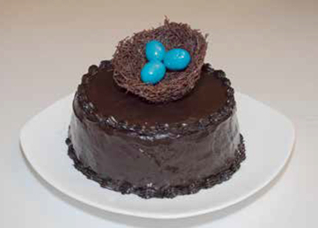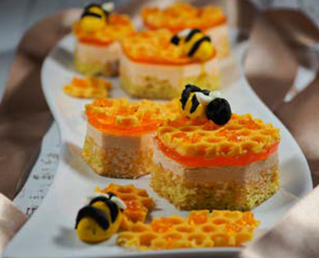
| Home | Source Reduction | Friends of Green Friends | Newsletters |
| Gardening | Resources | What You Can Do | Embracing The Trees |
| Pacific Northwest GreenFriends Newsletters |
| Trees, animals, birds, plants, forests, mountains, lakes and rivers - everything that exists in Nature are in desperate need of our kindness, of the compassionate care and protection of human beings. If we protect then, they in turn will protect us.
- Amma |
Nature as Art Cakes
| Campfire Cake | |
| Tree Stump Cake | |
| Pumpkin Cake | |
| Frog Gake | |
| Robin Cake | |
| Sakura Cake | |
| Bee Cakes |
| Nature as Art - Campfire Cake |
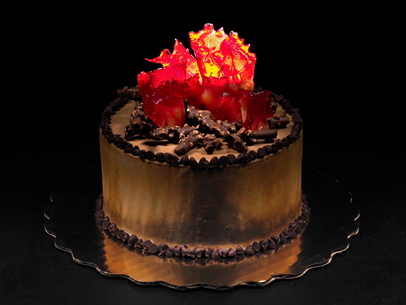 A simple chocolate campfire cake that glows like a real fire when light shines behind it! The fire was made with melted red and yellow hard candy broken up into shards of different sizes. The logs for the candy fire were made with Almond Pocky |
| It is no doubt that one of the most treasured camping pastimes is sitting around a warm, crackling campfire on a cold night making s'mores while sharing stories with family and friends. However, this timeless activity causes risk not only to people and wildlife but is also detrimental to the environment. This is not to mean we should stop burning campfires entirely; rather, we should be mindful of their environmental impact and follow safety guidelines to avoid an unintentional wildfire.
Burning wood releases immense amounts of carbon dioxide along with many other toxic volatile organic compounds (VOCs). Carbon dioxide is a greenhouse gas that heavily contributes to global warming. Additionally, toxic particles released from the burning of campfires may pollute water sources from fire ash, harming marine life living in these waters and wildlife that drinks from these water sources. Above all other consequences, the most dangerous is the risk of starting a wildfire. According to a 2017 report from the U.S. Department of Agriculture (USDA), close to 85% of wildfires in the US are caused by human carelessness. Although this includes other categories like the burning of debris, discarded cigarettes, acts of arson, fireworks, and equipment malfunctions, unattended or improper campfires contribute a significant portion of the total number of wildfires. Wildfires can decimate forests and homes, destroy natural resources, cause fatalities, and pollute the air. In what's referred to as a positive feedback loop, climate change accelerates the frequency and intensity of wildfires, and the carbon released from these fires exacerbates climate change - and the cycle continues. Although we cannot stop wildfires due to the already worsening effects of climate change, we can be more mindful of our use of campfires and follow safety guidelines to ensure minimal damage. For example, a campfire should not be built if there are adverse weather conditions such as dry land or windy air as these conditions may cause sparks from a fire to spread. Additionally, campfires should be built away from overhanging branches and ideally circled with rocks, as they do not allow fire to spread. Lastly, do not ever leave a fire unattended. Aside from precautions in building a campfire itself, there are also ways to be environmentally conscious while using it. Trash should never be burned in the fire as it may release harmful chemicals into the air. It is also preferable to avoid using chemically treated wood for a campfire. Instead, opt for natural wood from dead sticks. - Sonali Source/More information: Forest Service Research Data Archive (usda.gov) Are Campfires Bad for the Environment? (glampingorcamping.com) Wildfire Causes and Evaluations (U.S. National Park Service) |
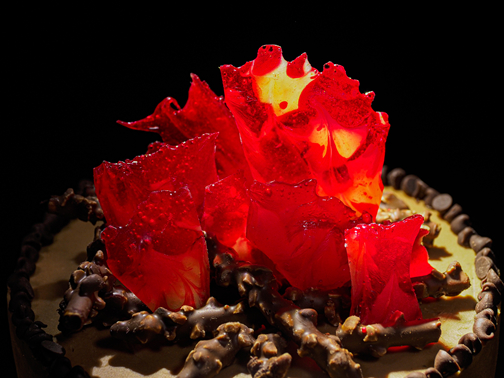 |
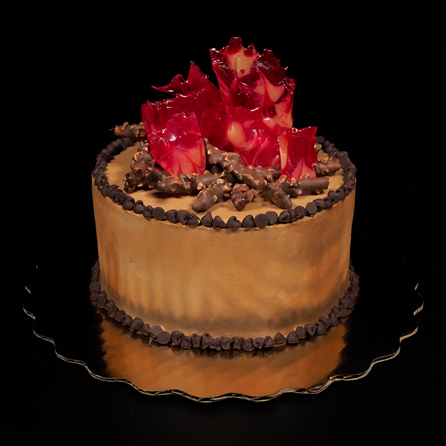 Stages of the campfire cake |
| Nature as Art - Chocolate Tree Stump Cake |
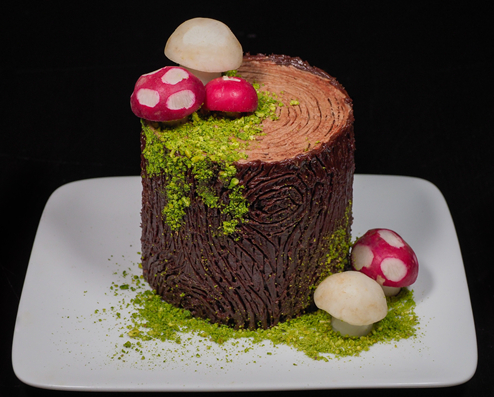 |
| Nature as art speaks to Sonali, and she speaks to deforestation.
"A simple chocolate tree stump cake featuring colorful mushrooms and moss trickling along the sides! The cake was covered in slightly different shades of chocolate frosting, then I brushed some cocoa powder on the top edges to add some shading. For the indentations on the side, I used a fork and dragged it along the frosting in straight lines and circles. The moss was made with crushed pistachios. Deforestation is the intentional clearing of trees or forested land, especially on a large scale. The effects of deforestation have been extremely detrimental as it has significantly transformed landscapes around the globe. One of the devastating consequences of deforestation is the release of carbon dioxide, which exacerbates global warming. The carbon inside the tree's chemical composition from photosynthesis is emitted into the atmosphere as carbon dioxide when the tree is burned. Another result of deforestation is the extinction of biodiversity as many tropical forests house habitats for many species, as those species are threatened when the trees surrounding them are logged or burned. Additionally, soil is more likely to erode when trees are removed, and this dry land puts plants more at risk to fires. Deforestation has also been linked to disease outbreaks in the past as wild animals are driven closer to human civilizations, creating a greater chance of zoonotic diseases transferring to human populations. A few of the causes of deforestation include agriculture, cattle ranching, logging, and housing. Agriculture is one of the most outstanding causes as certain agricultural practices - such as slash-and-burn agriculture - are responsible for the removal of substantial portions of land. The issue with these techniques is that they can unintentionally set fires to other parts of forests, including those that were supposed to be protected. Smoke from these fires can further limit rainfall and make them even harder to extinguish. Another cause is cattle ranching, as large fast-food companies account for mass deforestation when they create space to raise cattle for their meat supply. Additionally, logging is a common cause of deforestation, as the trees are used to produce paper products. The most damaging type of logging is clear-cutting, where an entire area of forest is cut down completely with nothing spared. Lastly, housing is a major cause of deforestation as it is powered by overpopulation - one of the most critical and complicated issues at the root of many environmental crises. Solving deforestation not only conserves precious wildlife but also serves as an effective method to fight global warming. The most influence lies in the hands of larger corporations. Holding these companies and their suppliers accountable for their unsustainable practices in their supply chains and ensuring they implement their promises to protect our environment, is a critical step to minimize the effects of deforestation. However, on an individual scale, making more informed and sustainable choices would help advance this movement for change. You can do so by reducing your waste, steering clear of single-use packaging, eating sustainably, and opting for recycled wood products (or products sourced responsibly)." Source/More information: Deforestation | National Geographic Society What Exactly Is Deforestation Doing to Our Planet? - EcoHealth Alliance |
 |
 The evolution of the tree stump cake |
| Nature as Art - Pumpkin Cake |
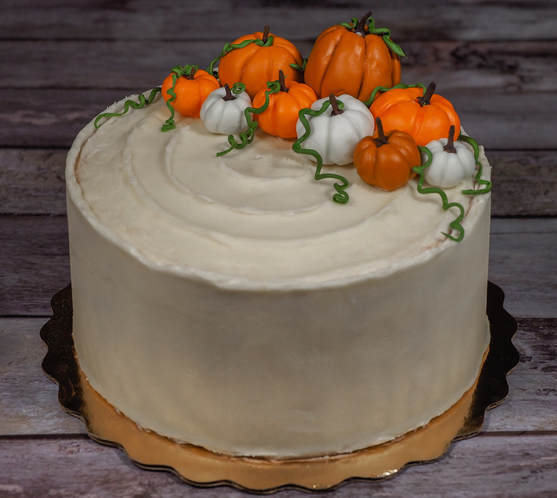 |
| Continuing with the theme of Nature as art, Sonali wrote this insightful article on pumpkins.
"To celebrate Halloween, I made a simple pumpkin patch themed cake. I went to a pumpkin patch and used the picture as an inspiration for the pumpkins on the cake. To make the pumpkins, I wrapped orange and white fondant around store bought chocolates. Then, I used a toothpick to create the indents in the side. Lastly, I used green colored fondant and wrapped it around a toothpick to create curly vines. Once the green fondant had dried, I was able to place them around the pumpkins on the cake! When I was making this cake, it made me wonder: What happens to all those pumpkins used for Halloween? Shockingly, an estimated 1.3 billion of the 2 billion pumpkins grown in the US each year end up trashed in a landfill. When these scraps decompose in a landfill, they do so without oxygen and release methane instead, one of the greenhouse gases contributing to climate change. How can we avoid Halloween pumpkin waste? One way is to either find a local collection center or zoo that will properly dispose of your used pumpkins. Many zoos accept these donations as they provide nutritional value that many of their animals need. You can also compost your pumpkins, especially if they have mold as it can be potentially harmful to animals. Additionally, you should clear out all the pumpkin seeds before composting to avoid germination and growing more pumpkins inside. If you don’t have a compost bin, you could let it decompose naturally. If the pumpkin is uncarved, clean out the insides which you can use for cooking or put the seeds into a bird feeder after drying them for birds to enjoy. Remove any decorations from the pumpkin such as candles. Smash your carved pumpkin and let it rest somewhere in your backyard, ideally with sun. Lastly, cover your pumpkin with a coat of leaves or soil and nature will do the rest. The pumpkins will enrich the soil and nourish any other plants nearby once they have broken down." Source/More information: https://www.sciencealert.com/an-astonishing-number-of-pumpkins-are-wasted-for-halloween-each-year https://sustainablefoodcenter.org/latest/gardening/oh-my-gourd-how-to-compost-your-pumpkins https://thebottomline.as.ucsb.edu/2018/10/the-pumpkin-feeding-tradition-at-american-zoos |
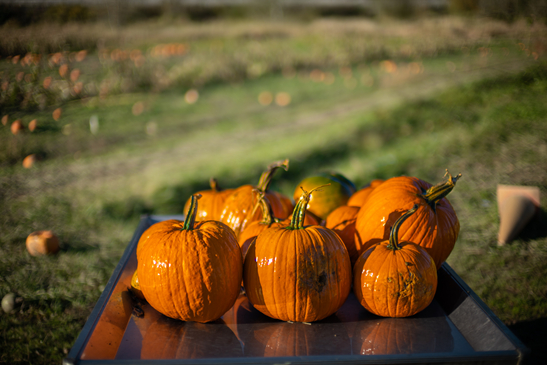 |
| Nature as Art - Frog Cake | ||||||
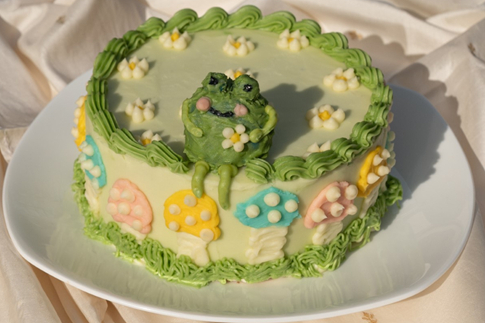 A cute frog cake surrounded by daisies and colorful mushrooms! |
||||||
| Sonali has contributed to the PNW newsletters with nature based cakes that bring awareness to environmental/ecosystem preservation.
"The decorations for this frog cake were all made from buttercream frosting mixed with different colors of food coloring. I used different frosting piping tips to achieve the mushrooms, bottom grass border, and top star tip border. My favorite part of this cake is the frog resting on top of the mushroom covered base! I made the frog by shaping fondant into an oval shape, covering it in green buttercream, and adding details like the facial features and limbs. The hardest part of this cake was cutting it and destroying the frog’s serene habitat! Thankfully, cutting a frog-themed cake doesn’t have any real impact on our ecosystems, but unfortunately, a lot of frog habitats are being destroyed in the real world causing a decline in the frog population. One of the primary causes for this downward trend is due to human activity such as urbanization, industrialization, tourism, mining, oil gas drilling, etc. Many potential consequences would happen if there were no more frogs. For example, disease outbreaks would be inevitable as mosquito populations would rocket. There would be a lack of nutrients for vegetation if there were a lot of insects living off trees. The food chain would be disrupted, and water in many ecosystems would no longer stay clean if there weren't any tadpoles to feed on the algae. A few ways you can help save the frogs are by expressing your concern to local, provincial, and federal government representatives; promoting the initiation of captive breeding and national parks; and funding conservation proposals by biologists, evolutionists, and pathologists." Source/More information: Save the Frogs (friendofthesea.org) See more nature cakes from past Pacific Northwest GreenFriends newsletters: |
||||||
|
|
2021
|
2020
|
2019
|
2018
|
| 2017 |
2016
|
2015
|
2014
|
|
2013
|
2012
|
2011
|
|
| Home | Source Reduction | Friends of Green Friends | Newsletters | Resources | What You Can Do | Contact Us |
For more information, e-mail info@greenfriendsna.org |
||||||


